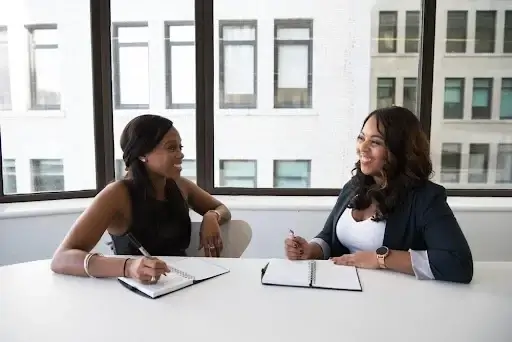Beyond Small Talks: Starters for Coaching Conversations
 One of the most valuable skills for leaders is knowing when and how to start a coaching conversation. This is one of the things that you may learn by getting a coaching certificate. It is also a concept that you may want to impart to those in your company the longest to let them know how to handle those who are new to the company. By having a coaching culture, there are more chances to develop talent, strengths, and loyalty and align them to the company’s goals and visions.
One of the most valuable skills for leaders is knowing when and how to start a coaching conversation. This is one of the things that you may learn by getting a coaching certificate. It is also a concept that you may want to impart to those in your company the longest to let them know how to handle those who are new to the company. By having a coaching culture, there are more chances to develop talent, strengths, and loyalty and align them to the company’s goals and visions.
Before moving forward, you may find it helpful to explore our free worksheet on uncovering “How To Make Friends.” You can download the worksheet here.
Knowing about coaching conversation starters can help people in the following things:
- It helps others become more self-aware
- Turning experiences into opportunities for learnings
- Reinforcing strengths
- Exploring weaknesses and challenges
- Teaching people to takin responsibility for their actions and development
These discussions which can happen in person, in virtual meetings, or even over small talks at work are truly a vital in the improvement of the work environment and interactions. By developing your executives’ and employees’ coaching skills, they learn to adapt a coaching culture, increasing employee engagement, collaboration, job satisfaction and morale, and teamwork.
Priming Prospect Coachees
The Secret Cues for Coaching Opportunities
Simple Steps for a Coaching Conversation
The tips in this article help life coach training professionals, as anyone can make a coaching conversation, especially when you are a leader. As the spearhead of a group, you also have to learn how to develop others and identify problems and find solutions.
Priming Prospect Coaches
Coaching conversations help create a better workplace culture as relationships are strengthened, increased engagement, performance improvement. But before things turn into a certified coaching session, there are three things that a coach and coaches need to establish, and they are the following (adapted from Samurai Coaching Dojo):
Rapport
Before establishing a coaching-coachee conversation, you have to first tap into having a person-to-person talk. This is where the small talk comes in, when you ask them how there are or share a little about yourself. But the thing is, there is a tendency to linger in this part of the conversation— having the longer small talk is all right when it’s the first conversation with a potential coachee or a client. But it would help if you kept in mind that small talks should be kept “small,” these social pleasantries are best done for a short period. Small discussions for building rapport are meant to provide the following:
- Comfort. In building rapport, the coach and prospect coachee will feel more at ease as they exchange answering social questions. This is where the two develop their foundation for easy, healthy, and helpful conversations.
- Connection. Small talks are about having simple questions and shallow curiosities to connect. Building rapport is about finding common ground to associate with and gauge a good grasp of how you can have fruitful coaching sessions in the future.
- Transition. Small talks can have rapport-building questions that can serve as a transition from the point of conversation to interest and improvement that your coaching can provide.
Context
After transition spiels and questions, you need to provide some context of what will happen. This is one of the things taught in a life coach certification program. This is especially helpful if it is the first time that you are to coach someone. The two of you can create a set of simple agreements like the following: Anything can happen. “For the next hour, let’s not restrict ourselves to the things that we believe may happen. Let’s try to open our minds to possibilities.” Complete honesty.
“There are parts of our life that we may not want to honest with but let’s agree to be honest with one another — you tell me about what’s going on, and I will tell you about what I really see without judgment. You do deep work. As a coach, you should do the deep insight but let your coachee control the depth. Some coaches coach on shallowly, only treading on the surface, but you can tell your coachee that they can say, “Can we delve deeper on this situation,” or “Hey, can we slow down?” 200% responsibility. In our daily life we usually just take 50% responsibility, and when the other person doesn’t meet us halfway, we drop to 40% responsibility or lower. But you can tell your coachee this “In our conversations, the only way to achieve what you want is when you agree to answer points even if I would be the dumbest questions you’ve heard.
On my part, I will agree to treat you as if your life-changing breakthrough is always just a question away even if you you’d be totally resistant and hesitating with answering.” The above are just a few ways to provide a context of how the coaching will happen. Remember that you don’t have to bring up these contexts for every coaching talk, but do make sure to provide a powerful context before agreeing with a coaching deal.
Presence / Awe
Michael Neil offers a simple coaching model in two steps:
- Show up
- Respond to what shows up
This model may be straightforward, but it’s also powerful because nothing is more effective in opening a conversation than being present with our clients and providing an open ear to their situations.
The Secret Cues for Certified Coaching Opportunities
 Not all prospect coachees are really hoping to have a coaching conversation, so as a coach, you have to be aware and identify when there’s an opportunity for a coaching conversation. It is crucial that you know whether it’s the right time and you’re ready and able to coach your people. The following are the conversation cues to recognize when someone is open to having a coaching dialogue:
Not all prospect coachees are really hoping to have a coaching conversation, so as a coach, you have to be aware and identify when there’s an opportunity for a coaching conversation. It is crucial that you know whether it’s the right time and you’re ready and able to coach your people. The following are the conversation cues to recognize when someone is open to having a coaching dialogue:
- “I need some help.”
- “Can you help me think things through?”
- “Could you give me a reality check?”
- “I’d like to hear some ideas off of you.”
With these cues, you can turn a typical conversation into a coaching opportunity.
Simple Steps for a Coaching Conversation
When you have encountered the cues enumerated from the previous sections, the following are three guidelines in holding a coaching conversation (CCL.org):
- Listen carefully.
- Respond thoughtfully.
- Resist imposing your solutions.
Listen carefully
This is why having good listening skills is essential for coaching. It will be taught in life coach training that even though you have heard the first part of their problem, you should not assume what the conversation is about or what path will take. Take the time to listen, letting them reflect, and express themselves honestly. Truly listening goes beyond active listening as hearing is different from understanding.
Listening to understand is about tuning into the different levels of information that is said beyond words. One level is the factual information being presented, which most of us usually tend to pay attention to. But one should also listen for the information behind the topic, and the emotions that people bring to an issue is an essential part – this brings us to the importance of looking out for non-verbal cues. We tap into unverbalized objections, reservations, and masked barriers that might be hampering your coachee’s perspectives and new initiatives in these different levels of information. when people are listening to understand one another, more vital and more robust solutions to business challenges emerge.
Respond thoughtfully
You may learn in life coach training that coaching isn’t about coming up with quick fix or first resolutions. Coaching is about uncovering answers through related inquiry, openness, and exploration. You can start by asking powerful questions that can draw out more information or stretch the other person’s thinking, these questions are the following:
Who else is affected in this situation?
What else could you do?
What else occurs to you?
Who else have you talked to about this?
These questions create mutual understanding about facts and reveal insights that wouldn’t have been brought to light quickly. You can also use a non-directive prompting question to inspire reflection and lead to insights. For example, you ask, “How do you want your team to feel when you announce the new initiative?” than just “When are you announcing the new initiative?”. While the latter question might help get the person inquiring up to speed, it isn’t compelling and isn’t likely to add value for the person answering, as they reiterate a straightforward fact that they already know; remember that you are hoping to find insight from them through their reflection not just finding facts that they are familiar with.
Make sure to set a relaxed tone, maintain eye contact, and give them plenty of time to think and respond to your questions. These antics encourage them to express themselves — without you agreeing or disagreeing and without feeling like they are being judged for their actions.
Resist imposing your own resolutions
Shift away from the standard and natural tendency of everyday conversation to want to problem-solve or give advice. There are times to direct or provide answers, but coaching dialogs are about the other person’s learning and improvement — not about your opinion or expertise.
The real art of conversation is in balancing the mix of challenge and support. Providing support includes reassuring people that they’ve been heard and, primarily, that their feelings and values are valid and understood. It gives a sense of psychological safety, trust and encourages honesty and transparency. When that ratio is correct and more genuine than formulaic, the challenge is received and fosters more constructive discussion than triggering their defensiveness.
As you listen carefully, respond thoughtfully, and resist imposing your solution, you now have the basis of a coaching conversation.

Whether a conversation was a planned coaching conversations or a spontaneous moment, you now have opened the door to valuable learning, new action, and new thinking. And when coaching session start to happen all across your organization, you have the foundation for a solid organization-wide coaching culture.
Ready to strengthen your coaching conversations and build better relationships? Download our free worksheet to explore deeper self-awareness and improve your coaching skills.







